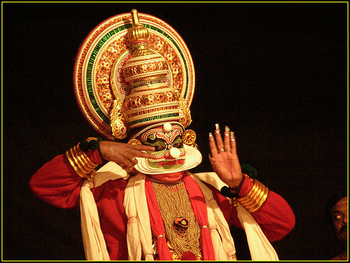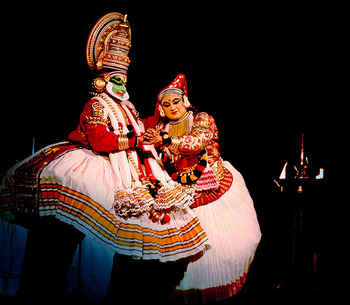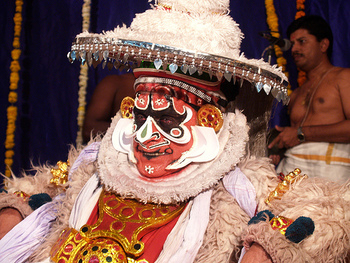Kathakali
Kathakali is a traditional Indian dance drama. It was created more than three centuries ago in what is now Indian state of Kerala. Word kathakali comes from the Malayalam words "katha" (story) and "kali" (play).
 Story is told with hand gestures, facial expressions and
other body movements
Story is told with hand gestures, facial expressions and
other body movements
According to tradition there are 101 stories that should be performed in Kathakali. But, nowadays only about one third of this number are performed. It is interesting to mention that originally these stories were written to last whole night long. Today only shorter versions, lasting 3 or 4 hours, are performed. Sometimes only parts of one story are performed. The most popular stories in Kathakali are "Nalacharitam" (which is a story from the Mahabharata), "Kalyanasougandhikam" (which is story where Bhima is bringing flowers to his wife Panchali), "Kiratham" (Arjuna and Lord Shiva's fight, according to the Mahabharata) etc. To make Kathakali more popular stories from other cultures like for example William Shakespeare's King Lear or Goethe's Faust are performed.
 Kathakali - traditional Indian drama
Kathakali - traditional Indian drama
Songs in Kathakali are sang in Manipravalam. This medieval literary style of South India combines Malayalam and Sanskrit. Most songs are set in ragas based on Carnatic music. Music in Kathakali is played by groups of about 14 persons. Musical instruments used in the performances are "chenda" (cylindrical percussion instrument) and two kinds of drums called "maddalam" and "edakka." In Kathakali there are two singers. There is a lead singer called "ponnani" and his follower called "singidi." Ponnani is similar to conductor in western music. Ponnani and singidi use "chengila" (metal gong struck with a wooden stick) and "ilathaalam" (a pair of cymbals).
In front of those performing Kathakali there is a big lamp called "kalivilakku." Let's now move to drama in Kathakali. Each actor in Kathakali is very skilled and must have high level of concentration and physical power. That is why many of them practise ancient Indian martial art called Kalaripayattu. The training lasts up to 10 years. The actor "tells" the story with 24 hand gestures or "mudras", facial expressions or "rasas" and other body movements. The control of eye movement is also very important.
 Kathakali actor
Kathakali actor
The main facial expressions in Kathakali are called "navarasams" or "navarasas." They are Sringaram (love, affection), Hasyam (mockery, humour), Bhayanakam (fear), Karunam (pity, compassion), Roudram (anger, fury), Veeram (bravery), Beebhatsam (disgust), Adbhutam (wonder, amazement) and Shantam (peace). Very important aspect of Kathakali is the make-up of performer's face. There are five types of make-up in Kathakali - Pachcha, Kathi, Kari, Thaadi and Minukku. They differ by the colour which dominates in them. In Pachcha, for example, the dominant colour is green. Different colour describes different characters. Green colour is used to describe noble man. Demons have red faces and red beards.
There are three main styles of Kathakali - Vettathu Sampradayam, Kalladikkodan Sampradyam and Kaplingadu Sampradayam. Kathakali is male dominated. Still some Kathakali groups include female artists. One of such groups is the one in Kerala temple town of Tripunithura.